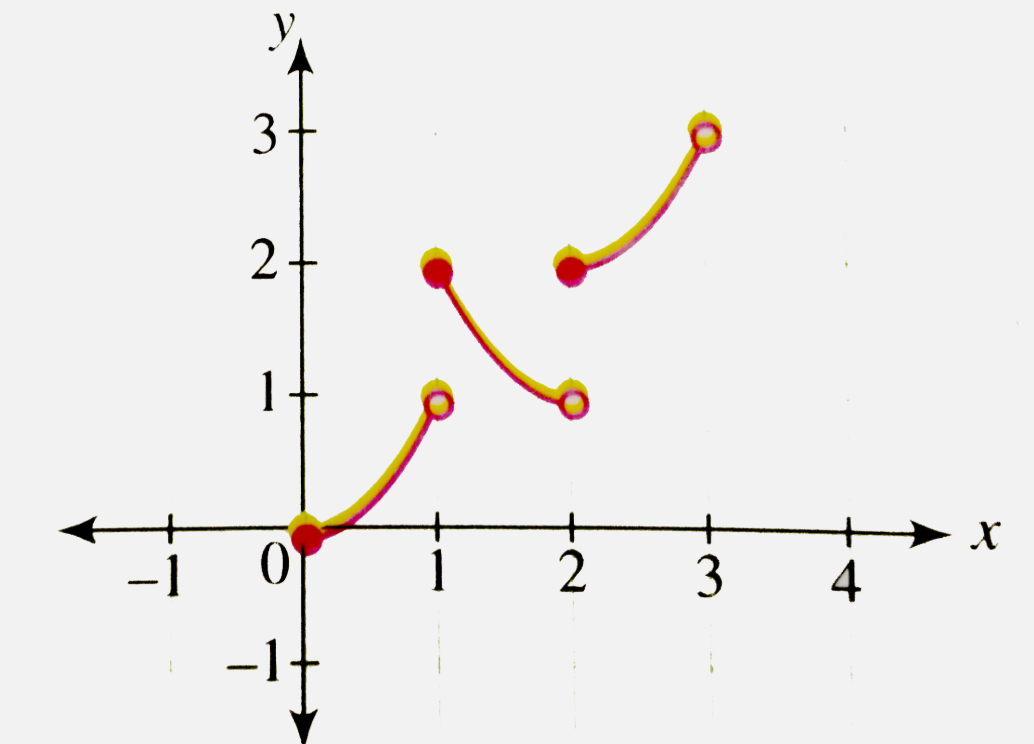If fandg are two functions defined on N, such that f(n)−{2n−1ifniseven2n+2ifnisodd and g(n)=f(n)+f(n+1). Then range of g is {m∈N:m= multiple of 4} { set of even natural numbers} {m∈N:m=4k+3,k is a natural number {m∈N:m= multiple of 3 or multiple of 4}Solution in Tamil
{ m ∈ N : m = multiple of 4}
{ set of even natural numbers}
{m ∈ N : m = 4k + 3, k is a natural number}
{m ∈ N : m = multiple of 3 or multiple of 4}
The correct Answer is:C
g(n)=f(n)+f(n+1)
If n is even, n+1 is odd.
∴ g(n)=2n−12(n+1)+2=4n+3
If n is odd, n+1 is even.
∴ g(n)=2n+2+2(n+1)−1=4n+3.
Topper's Solved these Questions
- BOOK - CENGAGECHAPTER - FUNCTIONSEXERCISE - Multiple Correct Answers Type10videos
FUNCTIONS
- BOOK - CENGAGECHAPTER - FUNCTIONSEXERCISE - Comprehension Type7videos
FUNCTIONS
- BOOK - CENGAGECHAPTER - EQUATION OF PLANE AND ITS APPLICATIONS -IIEXERCISE - DPP 3.418videos
EQUATION OF PLANE AND ITS APPLICATIONS -II
- BOOK - CENGAGECHAPTER - GETTING STARTED WITH GRAPHSEXERCISE - Exercise18videos
GETTING STARTED WITH GRAPHS
Similar Questions
The function f(x)=cos−1⎛⎝2[|sinx|+|cosx|]sin2x+2sinx+114⎞⎠ is defined if x belongs to (where [.] represents the greatest integer function)
04:31View SolutionLet f(x)=x2−2x−1∀x∈R Let f:(−∞,a]→[b,∞), where a is the largest real number for which f(x) is bijective. If f:R→R , g(x)=f(x)+3x−1 , then the least value of function y=g(|x|) is
View SolutionLet A(0,6,6), B(6,6,0) and C(6,0,6) are three points and point D is moving on the line x+z−3=0=y. If G is centroid of ΔABC, then minimum value of GD is
View SolutionDoes the following graph pass the vertical or horizontal line test ?
 02:25View Solution
02:25View SolutionIf fandg are two functions defined on N, such that
f(n)={2n−1ifniseven2n+2ifnisodd
and g(n)=f(n)+f(n+1)
Then range of g is
(A) {m∈N:m= multiple of 4}
(B) {set of even natural numbers}
(C){m∈N:m=4k+3,k is a natural number
(D) {m∈N:m=multiple of 3 or multiple of 4}07:52View SolutionLet m,n be two positive real numbers and define f(n)=∫∞0xn−1e−xdx and g(m,n)=∫10xm−1(1−m)n−1dx.
It is known that f(n) for n gt 0 is finite and g(m, n) = g(n, m) for m, n gt 0.
∫∞0xm−1(1+x)m+ndx=17:54View SolutionLet m,n be two positive real numbers and define f(n)=∫∞0xn−1e−xdx and g(m,n)=∫10xm−1(1−m)n−1dx.
It is known that f(n) for n gt 0 is finite and g(m, n) = g(n, m) for m, n gt 0.
∫10xm(loge.1x)dx=03:18View SolutionLet f be real valued function from N to N satisfying. The relation f(m+n)=f(m)+f(n) for all m,n∈N.
If domain of f is first 3m natural numbers and if the number of elements common in domain and range is m, then the value of f(1) is04:31View SolutionThe number of ordered pairs (m,n)(m,nε{1,2,……..20}) such that 3m+7n is a multiple of 10, is
08:26View SolutionIfIm,n=∫π20sinmxcosnxdx, Then show that Im,n=m−1m+nIm−2,n(m,n∈N) Hence, prove that Im,n=f(x)={(n−1)(n−3)(m−5)(n−1)(n−3)(n−5)(m+n)(m+n−2)(m+n−4)π4 when both m and n are even
(m−1)(m−3)(m−5)(n−1)(n−3)(n−5)(m+n)(m+n−2)(m+n−4)}03:36View SolutionIf fandg are two functions defined on N, such that
f(n)={2n−1ifniseven2n+2ifnisodd
and g(n)=f(n)+f(n+1)
Then range of g is
(A) {m∈N:m= multiple of 4}
(B) {set of even natural numbers}
(C){m∈N:m=4k+3,k is a natural number
(D) {m∈N:m=multiple of 3 or multiple of 4}01:31View SolutionLet m,n be two positive real numbers and define f(n)=∫∞0xn−1e−xdx and g(m,n)=∫10xm−1(1−m)n−1dx.
It is known that f(n) for n gt 0 is finite and g(m, n) = g(n, m) for m, n gt 0.
∫10xm(loge.1x)dx=02:10View SolutionLet m,n be two positive real numbers and define f(n)=∫∞0xn−1e−xdx and g(m,n)=∫10xm−1(1−x)n−1dx. It is known that f(n) for n>0 is finite and g(m,n)=g(n,m) for m,n>0. ∫10xm−1+xn−1(1+x)m+ndx=
07:05View SolutionThe function f:N→N ( N is the set of natural numbers) defined by f(n)=2n+3 is
17:36View SolutionThe function f:N→N (N is the set of natural numbers defined by f(n)=2n+3 is :
02:51View SolutionLet f be real valued function from N to N satisfying. The relation f(m+n)=f(m)+f(n) for all m,n∈N.
If domain of f is first 3m natural numbers and if the number of elements common in domain and range is m, then the value of f(1) is03:28View Solution

